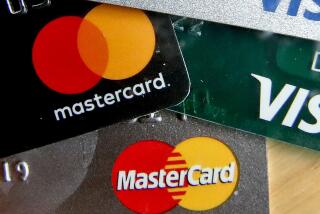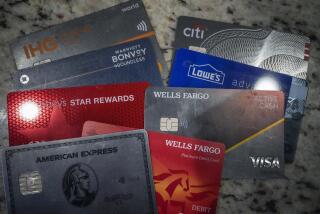The Next Crisis in the Banking Industry May Come From the Use of Credit Cards
- Share via
In the last 20 years, U.S. banks have jumped from frying pan to frying pan as they searched for rapid growth, high earnings and soaring stock prices.
In the 1970s, they made loans for farmland speculation and later for energy and real estate development in the Oil Patch states. In the 1980s, they plunged into highly leveraged transactions, followed by massive loans for commercial real estate construction. Much of this activity proved disastrous.
But the banks have not given up either their headlong pursuit of profits or their disdain for maintaining solvency despite the long string of lending disasters of the last two decades. Their next frying pan may well prove to be consumer installment loans, especially in credit cards.
The growth in bank loans to consumers since 1984 is second only to real estate loans. Banks were especially active in revolving loans, essentially credit card loans, which rose at a 16.1% annual rate in those years. In 1982, at the depth of the recession, banks held 52% of revolving loans, but that spurted to 66.8% in 1988.
And why not, when these loans were so profitable? Interest charges on credit cards rose in the 1980s, as state usury rate limits were lifted--most credit card rates are set at or near the top rate allowed in the various states. At the same time, the banks’ cost of funds, as represented by the three-month CD rate, declined sharply.
The spread between the bank’s cost of funds and credit card rates widened from 1.9% in 1981 to 11.8% in 1991. In addition, the rapid growth in credit card borrowing not only created mouth-watering lending opportunities for banks, but also attracted lots of new competitors, such as AT&T;’s Universal card and Sears, Roebuck & Co.’s Discovery card.
But as competition has heated up, banks and other credit card issuers have fought back. Warrantee extensions beyond those given by manufacturers are now common for people who use their cards when purchasing items, and fee waivers for the first year are now offered by many Visa- and MasterCard-issuing banks. Interest rate competition has even heated up. Issuers may not want to attract less credit-worthy borrowers, but they probably will as the interest rate wars intensify, resulting in higher delinquencies and charge-offs.
The introduction of intense competition among credit card issuers is reducing profits and it couldn’t come at a worse time. Households are struggling with the debts they incurred in the 1980s. Of course, the first loans to be paid on time are those backed by families’ homes. Next come payments needed to retain possession of their beloved cars. But credit card loans? They are definitely last in line. Small wonder that credit card delinquencies have shot up from 3.3% in 1990 to 4.6% this year.
Consumers are in a very cautious borrowing and spending mood. Consequently, consumer installment credit--total consumer borrowing excluding mortgage loans--declined for four straight months before its modest April uptick. This was the first time that consumer installment credit fell four months in a row since 1980. Revolving credit, however, shot up at a 12.4% annual rate in April--strongly suggesting desperation borrowing on credit cards by consumers hard-pressed for cash.
To put the final nail in the coffin of credit card profitability for banks, it is getting much harder and therefore more expensive for them to expand their business by signing up new qualified card holders. The average American adult now has eight credit cards, 2.5 of which are bank credit cards. A recent survey indicated that 21% of them plan to drop one card soon. The squeeze on bank credit card profitability is a real blow to those institutions with sour real estate, Third World and other loans, and snuffs out their one beacon of hope.
Recently, it was reported that Citicorp and First Chicago increased the loan rates on their credit cards.
Apparently, it was necessary because of skyrocketing credit card delinquencies and charge-offs that have squeezed profit margins to the point that various covenants would have required them to buy back pools of credit card loans they had sold to investors. Neither of these banks are in a position to easily replace that funding with money from other sources. The problems could become critical--Citibank’s consumer bank got 60% of its $1-billion profit in 1990 from credit card operations.
Whether credit card problems will prove big enough to seriously impair major American banks remains to be seen. It is clear, however, that stringent competition among credit card issuers is converging with slower growth in card holding, rapidly rising delinquencies and desperation borrowing on credit cards by consumers already in deep financial trouble.
If major difficulties develop, it should come as no surprise, and the banks could find themselves in the last frying pan, being cooked to a turn.
More to Read
Inside the business of entertainment
The Wide Shot brings you news, analysis and insights on everything from streaming wars to production — and what it all means for the future.
You may occasionally receive promotional content from the Los Angeles Times.










